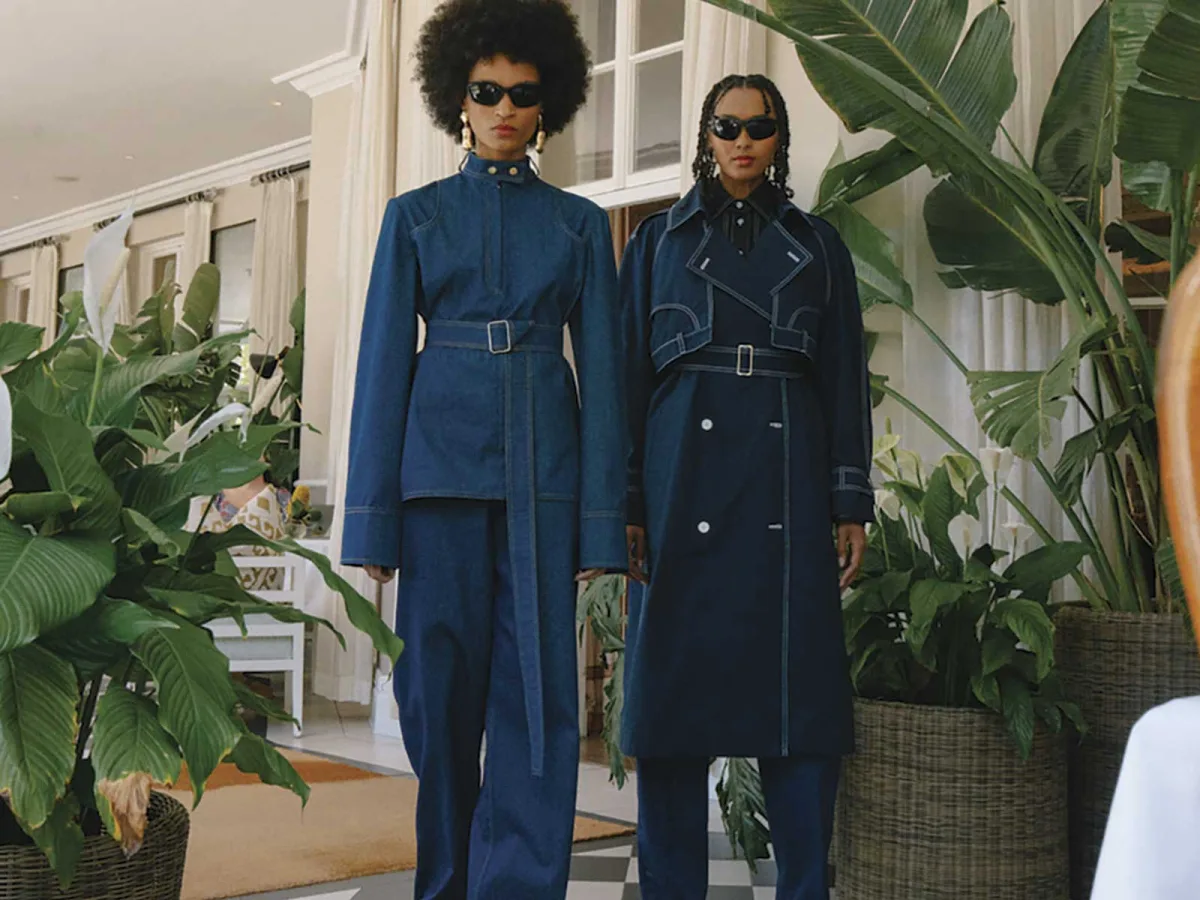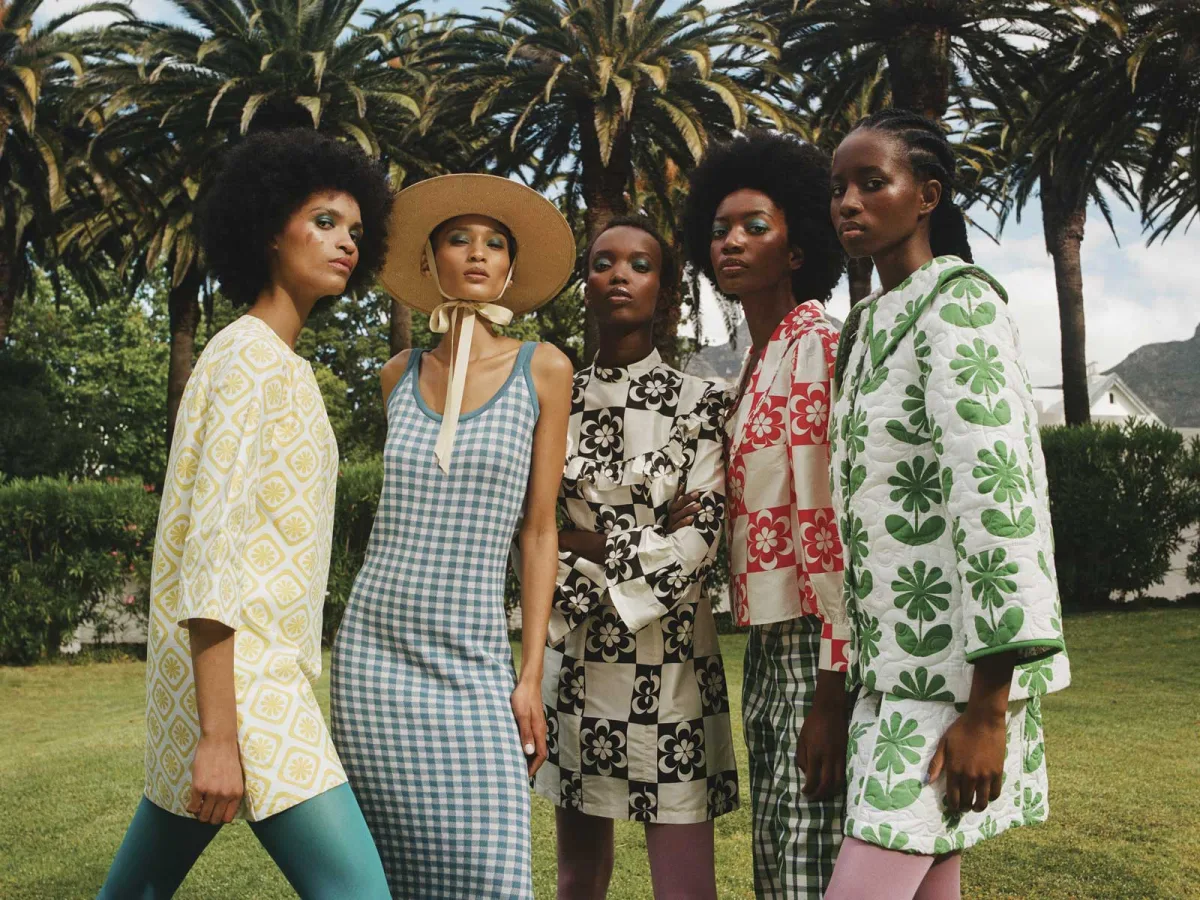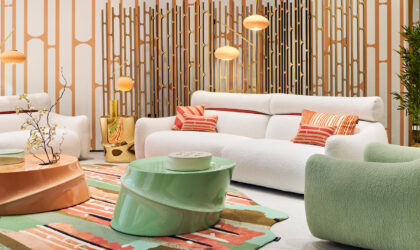On a perfect Saturday afternoon in November, a succession of uncommonly beautiful models strode between tables set up in the lounge, the conservatory-style restaurant and out on the terrace at the Mount Nelson, Cape Town’s preeminent colonial-style hotel.
By catwalk standards, their pace was slow, a kind of dreamy half-time measured to allow seated guests to take everything in. The soundtrack, meanwhile, packed a different kind of punch: beefy, streetwise, resoundingly urban African rhythms suggesting something cinematic, almost operatic – like the unfolding of a new era.
Among the gathered fans of Laduma Ngxokolo, creator of luxury knitwear brand Maxhosa Africa, some had travelled from Mthatha, Johannesburg and Durban to witness this moment. Others at the salon-style show were fashion acolytes and fellow designers lending support (and love) to a creative powerhouse many deem a superstar of his generation.
Ngxokolo did not disappoint.
In an era when European ramps are beset by tricksy upside-down dresses and fit-for-a-costume-party outfits featuring life-size animal heads, it was a joy to witness the showcasing of clothing with genuine soul, outfits expressing a vision, gutsy garments suffused with meaning beyond surface thrills and visual shocks.
The collection, which had already launched in London, involved no silly tricks or shortcuts, nothing inauthentic. Simply one sublime piece after the other, each outfit firmly rooted in Maxhosa’s brand identity, what Ngxokolo calls ‘an African cultural aesthetic in a modern context’.
From fit-for-a-king bathrobes to streetwear-inspired outfits for everyday use, exquisite blouses and pleated skirts, comfortable slacks and golf shirts, socks and stockings, cardigans and sleeveless tops, on display was also an extraordinary variety, each garment finessing the distinctive, graphic-style patterning, bold colour schemes and sumptuous detailing for which Maxhosa is known.
‘With every new collection,’ Ngxokolo says, ‘I try to figure out the zeitgeist, listen to the mood of the moment, be as honest as possible. I don’t create work that compromises, nor filter my thoughts. I always want some sense of educating, of having purpose and meaning behind everything we put out.’
The collection, ‘Alkebulan’, was named for an attribution for Africa that Ngxokolo says was used by globe-trotting Egyptians, Somalis and Ethiopians in pre-colonial times.
Dipping into a fantasy of this unheralded history, Ngxokolo says he imagined how these ancient Africans might have dressed; he tried ‘capturing that essence in a modern context’. How, he wondered, might Alkebulan’s world-travellers dress today?
And so, in a sense, he has constructed a line of Afrofuturist clothing – rooted in the cultural anthropology of the continent, it looks creatively to a dream of tomorrow.
Ngxokolo says ‘the love of culture, of heritage’ is in the DNA of every Maxhosa product. Each garment also expresses the brand’s identification with artisanal practices going back generations, and a commitment to working with local crafters using locally sourced fibres. The aim is to grow a sustainable local luxury fashion industry that not only exports to rich countries, but ends its reliance on imported textiles.
Heritage of the hand
If Maxhosa’s identity is built on culture and anthropology, then Sindiso Khumalo’s can be said to be nostalgia.
The Cape Town-based designer whose latest collection was also shown during the Mount Nelson’s weeklong series of fashion events, made her name when she shared in the coveted LVMH Prize in 2020. That same year she took the Independent Designer prize at the Green Carpet Fashion Awards.
Khumalo says she spends inordinate amounts of time in vintage stores and antique shops, ‘studying old portraits, being curious about what I see’.
‘I like exploring the past, digging really deep,’ she says. ‘I’m a classic nostalgic.’
Informed by this interest in the past, each of her covetable lines of clothing is built around research into a muse – a woman from history, either celebrated or unacknowledged. She says that tapping into history in this manner is ‘very healing, very important for my creative process.’
She’s also something of a textile geek. ‘I’m always researching new textile techniques. Or looking at old techniques that may have died out or are seldom used anymore.’
She says traditional fabrics contain stories to be uncovered. ‘Every garment in our collections starts with the textile and with a conversation around what it is we are we trying to say with that fabric.’
Like Ngxokolo, her love of textiles came via her mother who taught her to sew, aged 12. Her grandmother was a pattern cutter. ‘I still have her pattern book from 1947 – she taught my mom how to sew and then my mom taught me.’
Khumalo’s nostalgia bent also feeds into another obsession: handcrafted materials.
‘Just about everything is done by machine nowadays, which means that something produced by the hand is a great luxury,’ she says. ‘Where someone’s hand is involved in the act of creation – be it a sculpture, a painting, a dress – there’s tremendous value.’
To create the time-consuming, handmade elements in her designs, Khumalo forges long-term relationships with artisans, be they the in-house ladies who produce crochet components for her garments or the crafters in Burkino Faso making the handwoven cottons she uses.
‘I want to help maintain a heritage of the hand, make clothes that will last, that can be passed on to future generations,’ she says. ‘Making something by hand is a generous act… If I can translate that generosity into my clothing lines I feel like I’ve done my job.’

Beyoncé and beyond
Similarly passionate about handcrafted materials are Mmuso Potsane and Maxwell Boko, the duo behind Joburg-based fashion brand MmusoMaxwell. Their latest collection showed at the Mount Nelson a day after Maxhosa’s presentation.
Finalists for last year’s International Woolmark Prize which recognises rising fashion stars working with merino wool, they took home the competition’s Karl Lagerfeld Award for Innovation. In 2018, they grabbed the spotlight by designing an outfit for Beyoncé when she performed in South Africa.
Not bad considering they’d only teamed up in 2016.
Boko and Potsane say one struggle faced by African designers hoping to break internationally is pigeonholing. ‘There’s an expectation about clothing from Africa, a belief that you’re supposed to employ a certain aesthetic – bold, colourful, out there – to represent your culture or whatever,’ says Potsane. ‘That’s just not us.’
‘People tell us they expect to see a lot of colour because we’re from South Africa,’ says Boko. ‘They have this perception, and then are surprised by our aesthetic minimalism.’
The clean lines and tailored look of their designs may stray from expectations, but they are nevertheless rooted in their affinity for natural fibres, for handmade elements, and for a line of influence that they trace to the people who raised them: women.
‘The funny thing about our very patriarchal, heteronormative society is that most of us are raised by our mothers, our grandmothers, our aunts,’ says Boko. ‘They influenced and shaped us. You see in our early collections the very heavy interpretations of how our aunts and grandmothers dressed.’
Over time and with mounting confidence in their own creative instincts, they have edited and streamlined those influences to arrive at the chic modernism that defines their brand identity.
Also part of their creative DNA is a love for ‘that artisanal, handmade feeling’, which Potsane says they have instinctively always gravitated towards.
Boko says his affinity for handcrafted elements is linked to his formative years in ‘very rural’ Eastern Cape, where ‘we only got electricity in 2008 and we fetched water from the river’ – he believes that kind of childhood fostered a natural respect for what’s produced by hand.
Using natural fibres is also critically important, Boko says. ‘Not just because they are good for the earth, but because those fabrics look and feel better compared to, say, polyester.’
Potsane, who grew up in the Free State in ‘less rural’ circumstances and discovered fashion thanks to a daytime TV soap opera, says that another aspect of their brand’s personality is the articulation of cultural identity at the intersection of traditional craftsmanship and sophisticated design.
Without censoring themselves to fit external expectations of how African fashion should look, they’re creating outfits rooted in a heritage backstory, but expressed in unexpected, highly nuanced ways.
In other words, like Ngxokolo and Khumalo, they are telling African stories from an African perspective. And they are doing so in a fabulously contemporary medium: luxury fashion.
by Keith Bain





